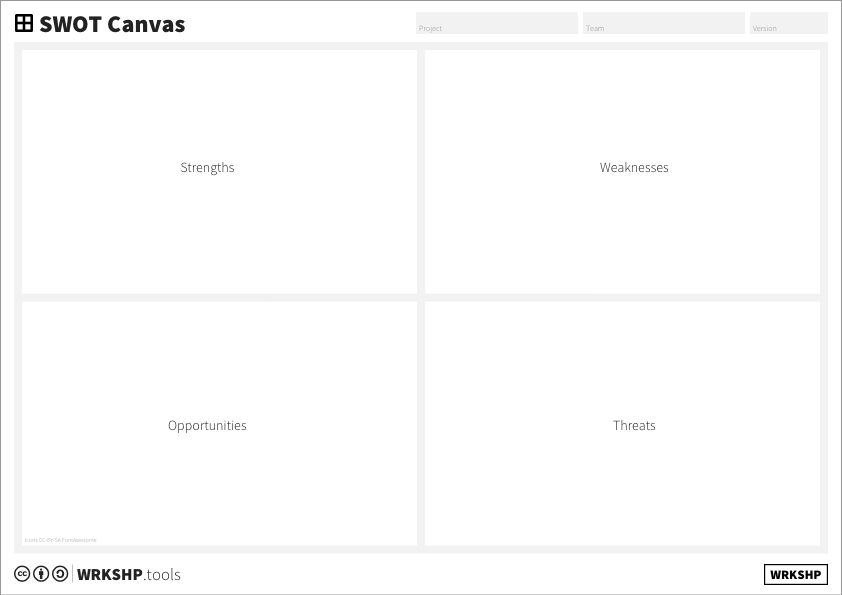SWOT Canvas
The SWOT (Strengths, Weaknesses, Opportunities, Threats) analysis is a traditional, but very effective tool to zoom in on one idea and really find out its strengths and weaknesses.
Use this tool when:
- you want to understand strenghts and weaknesses
Overview
| Time | ± 15 minutes | |
| Difficulty | 1 / 5 | |
| People | 3 - 5 | |
| Author | erik van der pluijm | |
| Website | ||
| License | CC BY SA 4.0 |

What is it and when should I use it?
Once you have made an affinity map and clustered your ideas, it is time to start filtering them down. There are many ways to do this, some work best for a small list of ideas, others work well for a large list.
The SWOT (Strengths, Weaknesses, Opportunities, Threats) analysis is a traditional, but very effective tool to zoom in on one idea and really find out its strengths and weaknesses. It can be made to work well with the design criteria scorecard in that respect.
Many of you will know how to do a SWOT analysis, but here I will give a brief overview. To effectively do a SWOT analysis you need a short list (3-5) ideas to compare. For each entry, going through the analysis will take a bit of time.
Tool Overview

Internal and External Factors On the vertical axis, the SWOT analysis splits internal and external factors working on your idea or situation.
Positive and Negative Factors On the horizontal axis, the SWOT canvas discerns positive and negative factors. Strengths and opportunities are positive, and weaknesses and threats negative.
Steps
1 Strengths and weaknesses
Go over your idea and come up with at least 5 strengths and 5 weaknesses. To make this easier, go over the different aspects of the idea you previously mapped to a cluster, and refer back to your earlier customer research.
Tip! To combine multiple ideas in one canvas, use different color postits per idea.
1 Opportunities and Threats
Go over the opportunities and threats that face your idea. What are opportunities or threats coming from the market, economy, competition, new technology, demographics, and changing customer preferences? What are the big uncertainties you face?
3 Compare
Compare the different ideas. Try to see if ideas have strengths that cancel out weaknesses, and that they have strengths that fit well to make use of opportunities.
Tip! A good way to do it is to give points. Strengths get +2, weaknesses -2, opportunities +1, and threats -1 point. Compare the scores of different ideas and see if (and how) they make sense.
4 Next Steps
Come back to your SWOT and compare the score with the next iteration of your idea. Did you manage to improve it? Did you cancel out negative points?
- You have filled the SWOT canvas for each of your ideas
- You calculated the score and compared
- You have an idea how to cancel negative aspects